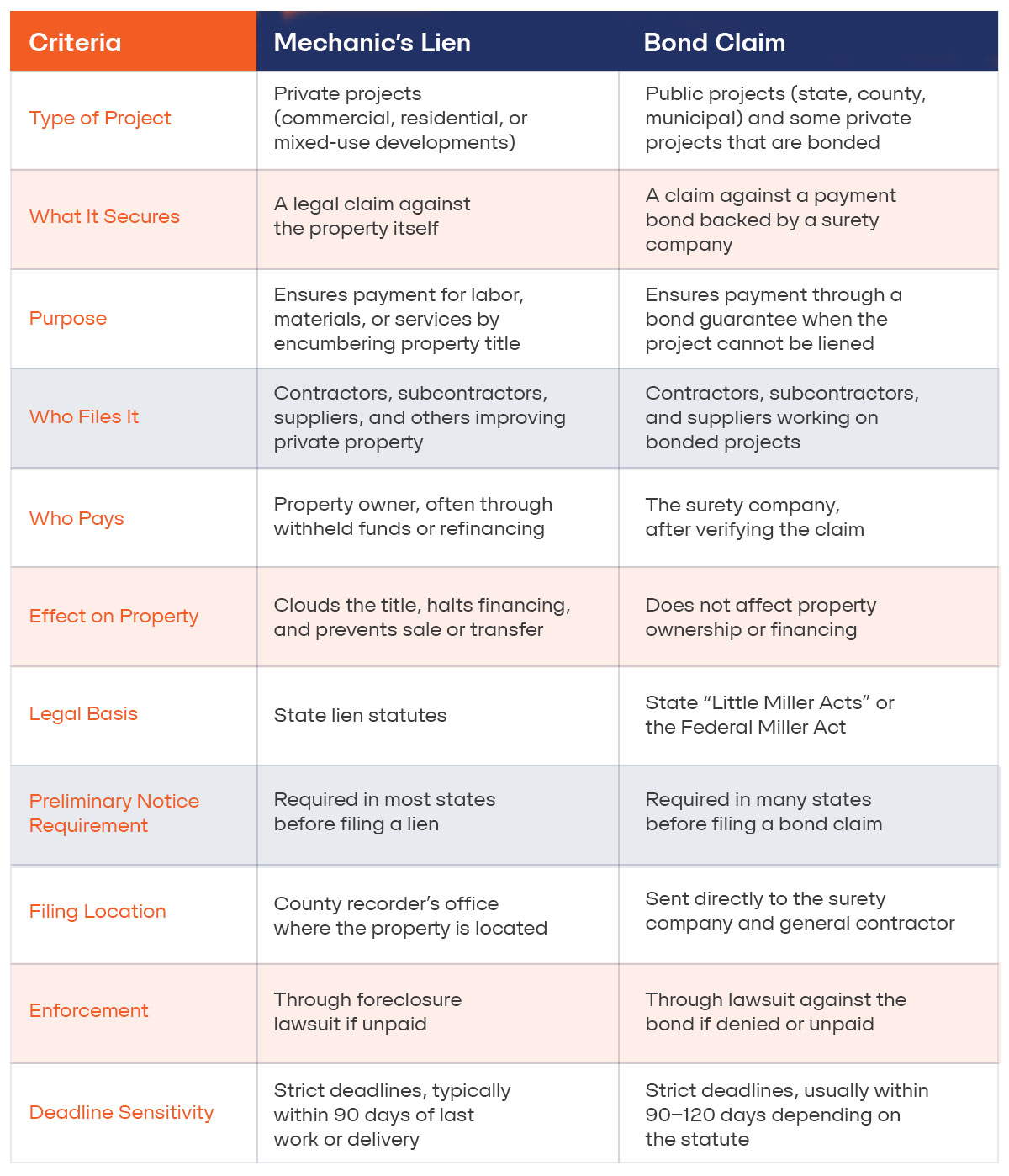Understanding Mechanic’s Liens and Bond Claims: A Complete Contractor’s Guide
In the construction industry, mechanic’s liens and bond claims are two essential legal remedies used to secure payment. Both protect contractors, subcontractors, and suppliers who have provided labor, materials, or services but have not been paid.
Last updated:
Nov
13
,
2025
Published:
November 13, 2025
3 mins
Read
In the construction industry, mechanic’s liens and bond claims are two essential legal remedies used to secure payment. Both protect contractors, subcontractors, and suppliers who have provided labor, materials, or services but have not been paid.
Although their purpose is similar, the type of project determines which remedy applies. Understanding whether to file a lien or a bond claim is crucial to protecting your payment rights and avoiding costly mistakes.
What Is a Mechanic’s Lien
A mechanic’s lien, also known as a construction lien, is a legal claim against private property that has been improved through labor or materials. It creates a security interest in the property, ensuring that those who have contributed to the project are compensated.
When properly filed, a lien clouds the property’s title and can stop funding or prevent the sale of the property until payment issues are resolved.
It is important to note that lien rights do not apply to public or government-owned property because the state cannot be forced to sell its land to satisfy a debt.
.jpg)
What Is a Bond Claim
A bond claim, also known as a payment bond claim, is a remedy used primarily on public construction projects where lien rights are not available. A payment bond guarantees that subcontractors and suppliers will be paid for their work, even if the contractor defaults.
These bonds are typically required under state “Little Miller Acts,” which mirror the federal Miller Act governing public projects. Some large private projects may also be bonded, offering similar protection.
.jpg)
Private vs Public Projects
Whether a project is public or private depends on who owns the land. If the property is owned by an individual or company, it is a private project. If it is owned by a government entity, it is a public project.
Private owners sometimes require bonds for large or complex developments. In those cases, a lien can still be filed, but it is often bonded off shortly after filing.
To determine whether you should file a lien or a bond claim, first identify the project type, confirm whether a bond exists, and obtain a copy of the bond if applicable.
How a Mechanic’s Lien Works
A mechanic’s lien is one of the most powerful tools available to construction professionals. It secures payment by legally encumbering the property. Once recorded, the lien becomes public record and can interrupt funding and prevent property transfers until the debt is resolved.
How to File a Mechanic’s Lien
Before filing a lien, there must be a valid contract, either written or oral. Most states also require a preliminary notice or Notice to Owner to preserve lien rights. The deadline to send this notice varies by state and is outlined in each state’s lien statute.
Failure to send the preliminary notice within the required time can forfeit your right to file a lien.
How a Bond Claim Works
A payment bond is typically filed by the general contractor at the start of a public project to protect subcontractors and suppliers. The surety company issuing the bond guarantees payment if the contractor fails to pay.
How to File a Bond Claim
If you are not paid as agreed, you can file a claim directly on the payment bond rather than on the property itself. Many states require a preliminary notice before filing the claim, so it is important to review your state’s bond laws and deadlines.
After a claim is submitted, the surety company will acknowledge receipt and request supporting documentation, such as invoices, contracts, and a sworn statement of claim. The surety will investigate and determine whether the claim is valid.
During this process, send copies of the claim to all relevant parties and respond promptly to any requests for information. The surety will notify the prime contractor, who may contest the claim. Regular follow-ups with the surety can help expedite the process.
If the surety denies or delays payment, your final option is to file a lawsuit against the bond, known as an enforcement action. This should only be pursued when other efforts to resolve the claim have failed.
Mechanic’s Lien vs Bond Claim

Both remedies are designed to ensure payment, but they apply in different contexts. Before taking action, identify the type of project and confirm whether a bond exists. Always follow your state’s notice and filing requirements carefully, as missing a single deadline can eliminate your right to recover payment.
Knowing when to file a mechanic’s lien or a bond claim—and how to do it correctly—can make the difference between getting paid promptly and losing your right to collect altogether.
Frequently Asked Questions
1. Can I file both a mechanic’s lien and a bond claim on the same project?
Yes, but only if the project is a private job that happens to be bonded. In that case, you can file a lien to protect your claim, and the bond will likely be used to release or “bond off” the lien soon after.
2. How do I know if a project is bonded?
You can ask the general contractor, project owner, or public contracting agency for a copy of the payment bond. For public projects, the bond is typically a matter of public record.
3. What happens after I file a mechanic’s lien?
Once recorded, the lien becomes part of the property’s title record. The owner or lender usually cannot sell or refinance the property until the lien is resolved or released, which often prompts faster payment.
4. How long do I have to enforce a lien or bond claim?
Lien and bond enforcement deadlines vary by state. In most states, you must file a lawsuit to enforce a lien or bond claim within one year from the date of filing. Always verify your specific state deadlines.
5. Can I still file a bond claim if I missed my preliminary notice deadline?
In most cases, no. Failure to send the required preliminary notice on time can forfeit your right to file a bond claim. Always track notice deadlines at the beginning of every project.
6. Who can file a mechanic’s lien or bond claim?
Eligible parties typically include general contractors, subcontractors, sub-subcontractors, material suppliers, and certain laborers. However, eligibility rules vary by state and by the claimant’s position in the contract chain.
7. How long does it take to get paid after filing a bond claim?
It depends on the surety’s investigation. If you submit complete documentation promptly, a valid claim can be resolved in a few weeks. Disputed claims or incomplete filings can take months.
8. Can filing a lien or bond claim harm my business relationship?
Filing a claim is a legal right, not a personal attack. Many experienced contractors view it as a standard part of protecting cash flow. Clear communication with the owner or GC can help maintain a professional relationship while enforcing your rights.




.jpg)
.jpg)






